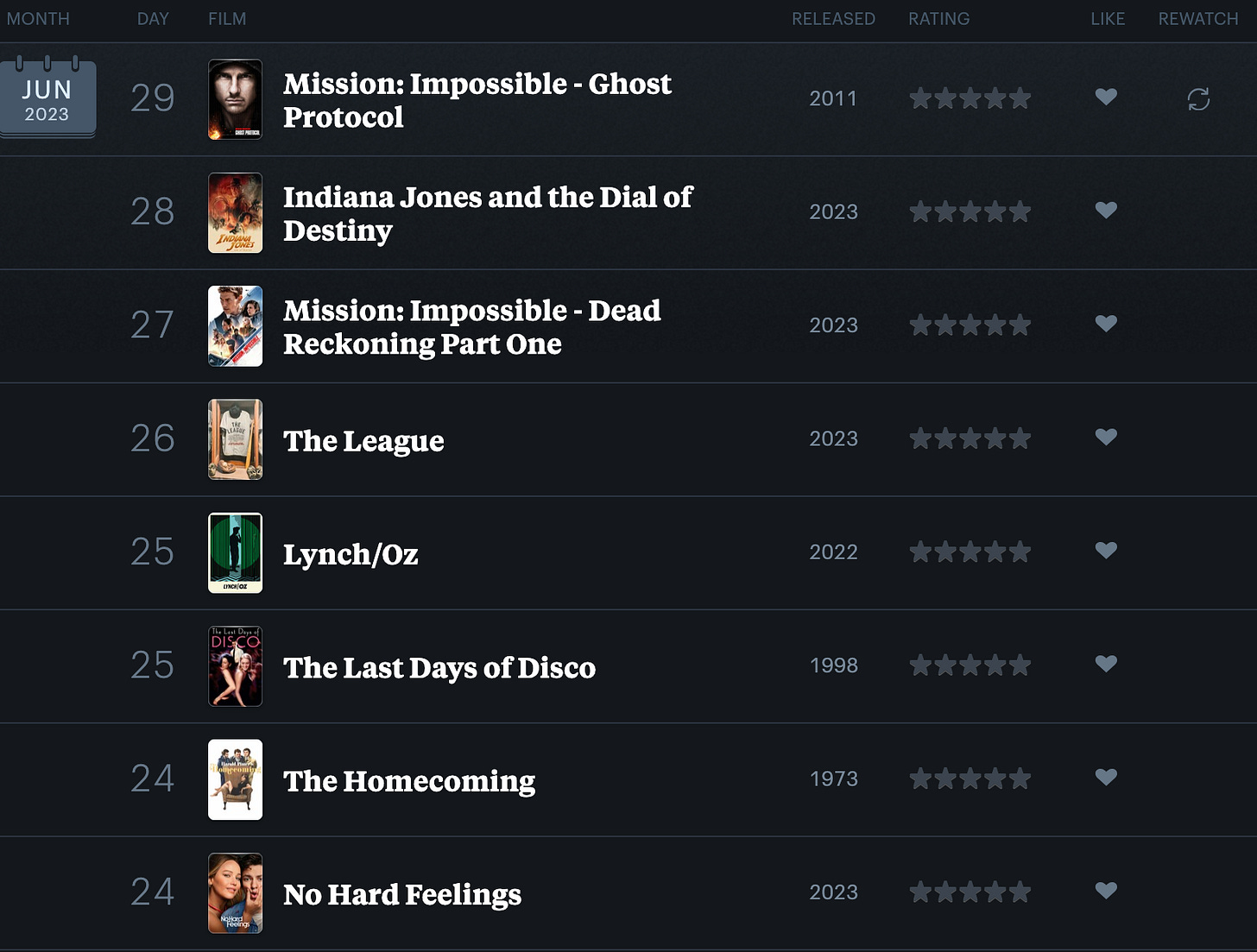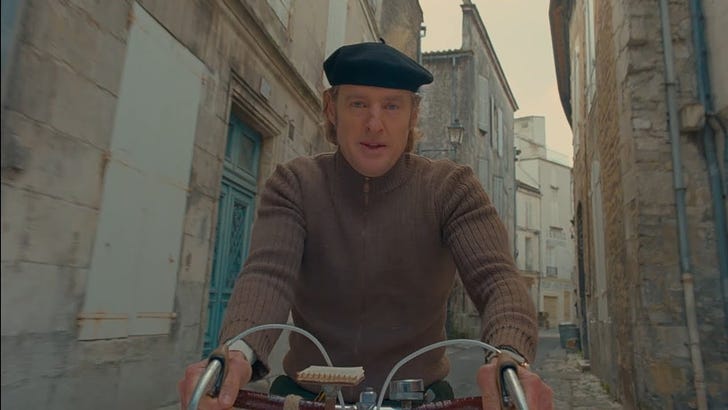Today, a new Indiana Jones film arrives in theaters. If you like the series, then you should find Dial of Destiny exactly what you expect and little more or less. I was mostly fine with that.
But today’s post isn’t about Indiana Jones, per se. It’s about the cultural climate that has whipped up a state of seemingly unshakeable ‘80s nostalgia. Harrison Ford’s archeologist, a man who quite literally excavated the past, embodies this golden-age thinking quite literally. I haven’t seen the originals (sans Raiders of the Lost Ark) since growing up, but I don’t remember Indy being quite such a finger-wagging scold as he is in Dial of Destiny. He’s older, of course, but the vivacity with which he disdains the hippies and radicals of the film’s 1969 setting felt a bit dialed up on the Clint Eastwood/“get off my lawn” energy.
Be it the sense of shared economic prosperity, the global political realignment around Western capitalist values, or the pop culture sounding a generally escapist note, the decade of Indiana Jones’ cinematic conception is widely considered a halcyon one. But with more distance from the period, a number of filmmakers have begun to ask a crucial clarifying question: “For whom?”
I’ll pull a quote from the estimable film critic J. Hoberman here from his book Make My Day: Movie Culture in the Age of Reagan.
“If the Sixties and early Seventies were, at least in part, periods of disillusionment, the late Seventies and Eighties brought a process of re-illusionment. Its agent was Ronald Reagan. His mandate wasn’t simply to restore America’s economy and sense of military superiority but also, even more crucially, its innocence […] Like an old movie or TV rerun, Reagan reversed the flow of time and remade our days.”
I’m fascinated by the following pairings of films that swim against the cultural currents of nostalgia and cast a critical eye on the 1980s — most of them from a historical vantage point. This is not to invalidate the experience of anyone who did/does enjoy the decade (I wasn’t there so who am I to really say). Rather, it’s to complete the picture and assess what the Reagan/Thatcher era meant for a wider range of experiences.
(ALTE)RED STATES
Presidential elections form the backdrops of the 1980-set Armageddon Time (available on Amazon Prime Video) and 1988-set Donnie Darko (available on Max). The former is an emotionally modulated moral drama about a young boy who must open his eyes to the reality of racial bias baked into the world around him. The latter is a surrealistic fantasy about a troubled boy who begins taking increasingly aggressive actions to rebel against a sterile suburban culture after seeing a rabbit-like Horseman of the Apocalypse. But both function like parables for future doom and gloom with the elections serving, within the context of the film, as a symbolic illustration for good not always triumphing. To James Gray and Richard Kelly, the event shows in microcosm how many would rather turn their heads in ignorance than face the real issues in society.
MAGGIE MALAISE
Whereas American liberalism largely crumbled in the Reagan era, the United Kingdom had a much more vocal pushback from the working-class people who often felt the pinch of Prime Minister Margaret Thatcher’s governance. That defiant streak has lived on within many of the country’s filmmakers who came of age in the ‘80s and saw their country a bit more honestly. Shane Meadows’ This Is England (available to rent on Amazon) follows the unfortunate path of radicalization of a cherubic young boy into a group of white supremacist skinheads. Steve McQueen’s Red, White, and Blue (available on Amazon Prime Video) from the Small Axe anthology examines the more insidious forms of racism faced by a Black police officer trying to push for equality from within an imperfect institution. Both are bleak portraits of a nation that refuse to indulge the fantasy of sunny outcomes for all.
DAS KAPITAL(ISM)
The call is coming from inside the house with John Carpenter’s 1988 They Live (available for free with ads on Tubi), a sci-fi flick of remarkable clarity when it comes to decoding — quite literally, in the context of the film’s notoriously revealing glasses — the insidious undercurrents of obedience under laissez-faire capitalism. That gnawing spirit of discontent with this idea that wealth = health lives on in Sean Durkin’s 2020 domestic drama The Nest (watch with a free one-week trial to AMC+). The promise of prosperity in the market leads a shaky couple to uproot from New York to the London suburbs, but they only find that their problems grow to fill the space they’re given. Don’t expect a “greed is good” type speech to illustrate the film’s economic philosophy, just keep this festering problem in the back of your head as you watch a husband and wife’s trust in each other slowly rot.
DISCO DEMOLITION NIGHT
The Reagan presidency often foils against the preceding administration of Jimmy Carter, a leader whose notorious “crisis of confidence” speech sent many Americans reeling in search of a traditional strong man. Carter’s conception of freedom coincided nicely with the disco era, a musical movement driven primarily by Black and queer communities that encouraged preparation for liberation by centering the voices frequently excluded from the conversation.
Paul Thomas Anderson’s Boogie Nights (available on Hulu), a two-decade epic of American art and commerce set in the world of pornographic film, quite literally uses the end of the disco era and the transition of decades to reassert that the ‘70s are the closest we’d come to honoring our ideals. Whit Stillman’s droll comedy of manners The Last Days of Disco (available to rent from various digital platforms) similarly laments the musical moment’s demise. Although unlike Anderson, who films from the POV of those involved in the scene, Stillman tells the death of disco from the perspective of the murderers. The yippy yuppies slowly begin to infest the disco clubs in the early ‘80s, choking out the Black and queer energy in their original dancing environments. The movement soon withers under mainstream visibility.
HERE, QUEER, AND SUFFOCATING
The ‘80s also played host to rampant homophobia, some of it stemming from the growing AIDS crisis deemed by the media as a “gay plague.” Todd Haynes’ Safe (available on Criterion Channel), where Julianne Moore’s suburban housewife begins to suffer from a mysterious “environmental illness,” refracts much of this tension (albeit through a very oblique lens that resists obvious metaphor). But even without the virus as a convenient excuse, the LGBTQ+ community faced targeting simply for being non-normative. That’s the tension in Georgia Oakley’s new film Blue Jean (now playing in select theaters), where a lesbian P.E. teacher in northern England simply wishes to do her job and live her life — you know, personal freedom — but faces an identity crisis thanks to a Thatcher-approved edict restricted the “promotion of homosexuality” in schools.
The titular Jean becomes a model citizen for a different kind of ‘80s mentality, one that I think really shows in the films I’ve selected. You can be a smiling citizen on the outside while you let the contempt that society feels toward your existence corrode you from the outside in.
You can always keep up with my film-watching in real-time on the app Letterboxd. I’ve also compiled every movie I’ve ever recommended through this newsletter via a list on the platform as well.
I had my first New York City live jazz experience — a perennial bucket list item — last weekend when I saw Ron Carter at the Blue Note. This legendary musician is the most recorded bassist of all time and has a musical lineage that dates back to his collaborations with Miles Davis.
Carter’s music has since been my soundtrack ever since — I’ve grown especially fond of this soothing track:
If you enjoyed Hannah Strong talking about The Bling Ring earlier this month in the newsletter, then you’ve got to read her appreciation of Emma Watson’s performance in the movie for i-D.
Those looking to dig deeper into what Asteroid City should look no further than this incisive examination of the film’s layers by Richard Brody in The New Yorker. (I also really enjoyed Jesse Hassenger digging into the film’s connection to Spielberg for Polygon.)
I spent most of the week working on a big piece that will publish in early July, but until then — you should take a look at these two awesome pieces that subscribers received in full in their inboxes!
Let's Not Forget THE FRENCH DISPATCH
As I was putting the finishing touches on this edition of newsletter, early box office reports indicated that Wes Anderson’s Asteroid City is overperforming expectations to open at nearly $10 million in its nationwide opening. Most specialized fare these days is lucky to make that in its entire theatrical run. The PR machine worked in overdrive on this …
Another Slice of LICORICE PIZZA
Today, filmmaker Paul Thomas Anderson celebrates his 53rd birthday. If the name of this 11-time Oscar nominee doesn’t ring a bell, watch the clip compilation below for a tour through a filmography that extends from explosions of youthful energy like
You can keep track of all the freelance writing I’ve done this year through this list on Letterboxd.
Talking ‘bout America to subscribers on the 4th of July.
Yours in service and cinema,
Marshall
















